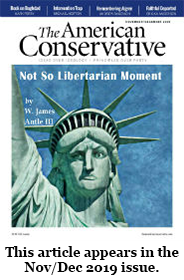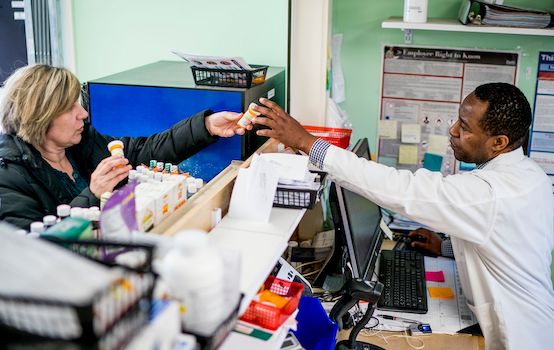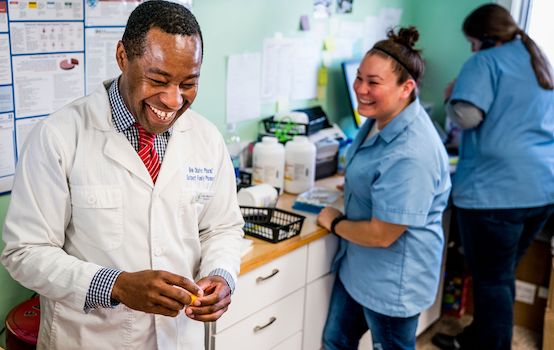Ben Okafor opened Eastport Family Pharmacy in 2014 in a Maine community that had not had one in over a decade (Credit: Coastal Enterprises, Inc./Gabe Sousa)
“Hold on,” Ben Okafor says when reached by phone one afternoon, “I have to find someone to hold the front desk.”

Okafor has his hands full, as he does most days, running Family Pharmacy, a business heopened five years ago in Eastport, a remote town along the coast of Maine just shy of the Canadian border. The pharmacy, which occupies a former laundromat a few blocks from Eastport’s working waterfront, bustles as Okafor and his staff consult with patients and fill prescriptions.
Before Okafor opened his doors, there hadn’t been a full-service pharmacy in Eastport for more than a decade. Picking up a prescription meant a 40-minute drive, and then a trip back. The community had become a “pharmacy desert,” a term that’s emerged in academic circles to describe an increasingly widespread problem.
Meeting this need for people in a distant corner of Maine has been rewarding for Okafor, who grew up in Nigeria and immigrated to the state in 2007. Starting a business from scratch has been no easy task, though. It has taken long hours and nights away from home. It’s also meant giving up a more stable job. Okafor originally came to the U.S. to work as a pharmacist at a Rite Aid location in Bangor, two hours west of Eastport.
Rite Aid offered stability in a new country for him and his family. But the job also gave Okafor an up-close look at the U.S.’s increasingly concentrated, chain-dominated pharmacy sector, and how poorly it serves people’s needs.
At Rite Aid, Okafor and other pharmacists were under constant pressure to dispense with patients quickly. The aggressive tactics that Rite Aid and two other chains—Walgreens and CVS—used to consolidate the market had shuttered locally owned pharmacies across northern and eastern Maine. The closings funneled more patients into the chains’ high-volume locations in cities like Bangor, while leaving entire regions bereft of a critical service.
At the Rite Aid in Bangor, Okafor regularly waited on patients who had driven more than two hours to pick up a prescription. “On a few occasions,” he told me, “they couldn’t arrive in time before the store closed.”
The experience led Okafor to open Family Pharmacy, where he takes his time with patients, knows many by name, and offers free delivery within a 50-mile radius.
On the one hand, Okafor’s story offers a hopeful look at how entrepreneurship could bring healthcare and economic vitality back to communities that have long been marginalized. .It also highlights the societal benefits of motivated immigrants, with an especially strong propensity to start businesses. And it demonstrates how independent pharmacies are often significantly better at meeting people’s healthcare needs than the big chains.
But Okafor’s story also illustrates just how stacked the deck is against independent businesses. For years, lawmakers and antitrust enforcers have looked the other way as CVS, Walgreens, and Rite Aid have bought up competing businesses, concentrated power, and used their ownership of key players in the health insurance market to self-deal.
These conglomerates are “really squeezing us,” says Okafor. The result is an uneven playing field that puts independent pharmacies at a significant disadvantage. Unless policymakers set things right, ventures like Family Pharmacy are likely to remain isolated anomalies—a solution that could have been, but wasn’t really tried.
Spreading Pharmacy Deserts
Up until the mid-2000s, residents in Eastport could fill their prescriptions in town at two local, independent pharmacies. Then Rite Aid bought and closed both businesses.
Now the chains themselves are consolidating. All of Rite Aid’s locations in Bangor, including the one Okafor used to work at, were shuttered this year after they and thousands of other Rite Aid outlets were acquired by Walgreens in a deal approved by the Federal Trade Commission. That’s left Walgreens as the only major drugstore chain in the Bangor region.
Meanwhile, large stretches of rural Maine have become pharmacy deserts, and even healthcare deserts, as hospitals and medical practices close or merge. Research has found that rural areas and minority neighborhoods in cities are especially vulnerable to becoming pharmacy deserts.
In these communities, often an independent pharmacy is the only thing holding the line against desertification. Between 2013 and 2017, the number of independent drugstores fell from about 23,000 to 22,000 locations. Their market share has been shrinking too and now stands at about 20 percent of prescription sales. Major chains, big-box stores, supermarkets, and mail order dispensaries capture the rest.
A majority of these independents are located in rural areas and small cities. If these locally owned pharmacies disappear, many communities would have no pharmacy at all. The same is true in urban black and Hispanic neighborhoods, which are much more likely to be served by independent drugstores than by chains.
It was while working at the Rite Aid in Bangor, and while picking up the occasional shift at another Rite Aid in Calais, about 40 minutes north of Eastport, that Okafor began to see the hardship facing people in Eastport and surrounding Washington County. Not only were many residents driving to Calais and Bangor for prescriptions, but healthcare services were lacking across the board.
Washington County has the highest uninsured rate in the state, at 16 percent of adults under 65. It also leads Maine counties in poverty. Nearly one in five households live below the poverty line. There’s also a significant elderly population, including many who do not drive.
Okafor’s entrepreneurialism was motivated by a mission. He set out to care for this community being neglected by chains, to do his part to repair the disintegrating healthcare system in rural Maine.
“We go beyond just filling prescriptions,” Okafor says. “We know our customers by name and face. We deliver their medications to their door. We check in on them, let their dogs out, whatever!”
Beyond the Bottom Line
“For the chains, it’s all down the bottom line,” Okafor says, from experience. The chains are big business, and they operate like big business. Quotas and metrics are the name of the game. Take the time they spend with patients: Okafor says overriding ethos in his role at Rite Aid was for churning out prescriptions. “We were supposed to get customers in and out in 15 minutes,” he complains.
That 15-minute rule was an official policy that Rite Aid debuted in 2011, offering customers gift cards if they had to wait longer. It was a sales gimmick that outraged pharmacists, however. State boards of pharmacy objected, citing a range of safety, ethics, and professional concerns.
While Rite Aid appears to have quietly dispatched with the rule as official policy, that 15-minute approach still persisted in practice during Okafor’s time there. It meant that he and his team never had enough time to get to know the patients and their healthcare needs.
Today at Family Pharmacy, Okafor and his staff can spend as much time consulting with patients as needed. Like most independents, Family Pharmacy also offers wellness checks and free screenings, plus an expansive suite of immunizations and medical supplies.

Okafor isn’t an exception when it comes to home delivery. A significant majority—71 percent, according to a National Community Pharmacists Association digest—of independent pharmacies provide this service, critical in rural areas.
This effort is not lost on patients, who people prefer independents across the board. A 2018 Consumer Reports survey found that patients felt significantly better cared for at an independent pharmacy. Over half said their pharmacist knew them by name—compared to only 14 percent of those with chain pharmacies. The consumer advocate magazine rated independents as the best choice for consumers, above all of the national chains.
Consumer Reports found independents won on price, too, by a country mile. “The price differences were remarkable,” the magazine reported. How remarkable? For a basket of five commonly prescribed drugs, independents had an average retail price of $107 for a month’s supply. Walgreens sold that same basket for $752, Rite Aid for $866, and CVS for $928.
The Threat of Big Rx
With better service, better prices, and no commute, customers should be easy to come by. Still, “You have to earn their respect,” Okafor says. In Eastport, residents had seen plenty of Main Street businesses close in recent years and some were skeptical that his could survive.
So far, Okafor is beating the odds. With the pharmacy attracting a steady stream of customers, last December he opened a second location, about an hour away, in the coastal town of Machias.
Ideally, Okafor’s ability to succeed would depend solely on his own business sense, his hard work, and the support of his patients. But the retail pharmacy market is not a fair and open one. It’s rigged.
For much of its revenue, Family Pharmacy depends on reimbursements from companies that oversee prescription benefits on behalf of insurers. These middlemen are known as PBMs, or Pharmacy Benefit Managers.
Today, just four PBMs control 75 percent of the market. Each of these PBMs operates its own mail-order pharmacy and the largest, CVS Health, also owns the nation’s second largest retail pharmacy chain.
This vertical integration creates powerful incentives to self-deal. PBMs often use their control over prescription benefits to steer patients to their own pharmacies. And they’ve been cutting reimbursement rates to independents, in some cases paying rates so low that local pharmacies lose money on many of the prescriptions they fill.
In Ohio, an ongoing, multi-year investigation by the Columbus Dispatch has found widespread anti-competitive behavior on the part of PBMs. This behavior includes price-gouging customers and lowballing reimbursements to competing pharmacies.
“At the same time the payments to pharmacies were being cut by the PBMs, the parent company of one of them, CVS, sent out letters to pharmacy owners sympathizing with their financial woes and offering to buy them out,” the Dispatch reported.
For Okafor, PBMs are a “huge issue.” Rivals like CVS “are really squeezing us,” he says. “Sometimes they will reimburse you at a lower cost, and if you complain, they remind you that ‘you signed an agreement.’”
These contracts seldom represent a legitimate negotiation. They’re take-it-or-leave-it deals. For pharmacists like Okafor, saying no would mean telling patients with that insurance plan that you can no longer serve them unless they want to pay out of pocket.
Bringing Back Real Competition
To date, the two agencies charged with enforcing the nation’s antitrust laws, the Federal Trade Commission (FTC) and the Department of Justice (DOJ), have looked the other way as PBMs flex their market power. The DOJ even greenlighted CVS’s merger with the health insurer Aetna earlier this year.
Some in Congress have grown frustrated by the FTC’s unwillingness to check the power of PBMs. In April, the House Judiciary Committee, led by Rep. Jerry Nadler (D-NY), unanimously passed along a bill sponsored by Rep. Doug Collins (R-GA) that would require the FTC to determine whether PBMs have engaged in anti-competitive practices.
The FTC has the power, through its rule-making authority, to restructure the pharmacy market. It could compel PBMs to spin off their retail pharmacies from their benefits operations. Doing so would restore competition to a badly broken market, opening the way for more pharmacists like Okafor to start businesses.
In the absence of federal action, states have been trying to limit the abuses of PBMs. Last year, Ohio changed how it contracts with PBMs for Medicaid benefits to block abuses of market power.
Other states are enacting transparency laws that allow pharmacies to see how PBMs price certain generic drugs. The most far-reaching approach is North Dakota’s pharmacy ownership law, which mandates that only licensed pharmacists may own pharmacies. Because of the law, nearly every pharmacy in the state is locally owned. North Dakotans pay some of the lowest drug prices in the country, receive a higher level of care, and have significantly more pharmacies servicing rural areas than any other state.
Back in Maine, Okafor has now hired four full-time staff at each location. To make it in his field, “You have to be a jack of all trades,” he says. He’s also counting on the investment he’s made in building relationships with the community. People like to do business with him because they understand his priorities.
But he’s often glancing over his shoulder at the giant conglomerates that control the terms in his industry. The last independent pharmacist in nearby Calais, Maine, closed his doors in 2014, citing the unfair competitive environment.
Expensive chain concentration, pharmacy deserts, and prescription commutes: this doesn’t have to be the future. Independent pharmacies like Okafor’s can flourish and multiply if we only let them. Yet that will require the political will to make some big players in the industry slow their expansion and play fair. It’s a pill that the U.S. government ought to swallow.
Stacy Mitchell is co-director of the Institute for Local Self-Reliance. Charlie Thaxton is a researcher with the Institute for Local Self-Reliance. His reporting is part of the institute’s Independent Business Initiative. This article was supported by the Ewing Marion Kauffman Foundation. The contents of this publication are solely the responsibility of the authors.




